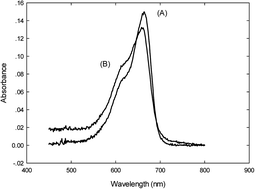Highly sensitive electrochemical detection of DNA hybridisation by coupling the chemical reduction of a redox label to the electrode reaction of a solution phase mediator†
Abstract
We have described a highly sensitive method for detecting DNA hybridisation using a redox-labeled stem loop probe. The redox labels were poly(styrene-co-acrylic) (PSA) spheres of 454 nm diameter, modified by methylene blue (MB) deposited alternatively with poly(sodium 4-styrene sulphonate) (PSS) in a layer-by-layer process. Each PSA sphere carried approx. 3.7 × 105 molecules of MB, as determined optically. DIG-tagged stem loop probes were immobilised on screen printed electrodes bearing anti-DIG antibodies. Binding with the target enabled straightening of the stem loop, which made attachment to the MB-coated PSA spheres possible. For measuring the current from the direct reduction of MB by differential pulse voltammetry, a 30 mer DNA target common to 70 strains of Escherichia coli was calibrated across the range 1.0 fM to 100 pM (gradient = 3.2 × 10−8 A (log fM)−1, r2 = 0.95, n = 60), with an LOD of ∼58 fM. By using Fe(CN)63−/4− as a solution phase mediator for the MB reduction, we were able to lower the LOD to ∼39 aM (gradient = 5.95 × 10−8 A (log aM)−1, r2 = 0.96, n = 30), which corresponds to the detection of 0.76 ag (∼50 molecules) in the 2 μL analyte sample. We hypothesise that the lowering of the LOD was due to the fact that not all the MB labels were able to contact the electrode surface.


 Please wait while we load your content...
Please wait while we load your content...